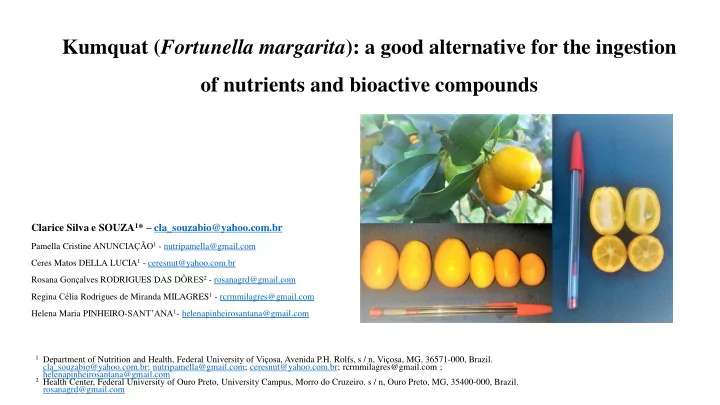

Kumquat ( Fortunella margarita ): a good alternative for the ingestion of nutrients and bioactive compounds Clarice Silva e SOUZA 1 * – cla_souzabio@yahoo.com.br Pamella Cristine ANUNCIAÇÃO 1 - nutripamella@gmail.com Ceres Matos DELLA LUCIA 1 - ceresnut@yahoo.com.br Rosana Gonçalves RODRIGUES DAS DÔRES 2 - rosanagrd@gmail.com Regina Célia Rodrigues de Miranda MILAGRES 1 - rcrmmilagres@gmail.com Helena Maria PINHEIRO- SANT’ANA 1 - helenapinheirosantana@gmail.com 1 Department of Nutrition and Health, Federal University of Viçosa , Avenida P.H. Rolfs, s / n, Viçosa , MG, 36571-000, Brazil. cla_souzabio@yahoo.com.br; nutripamella@gmail.com; ceresnut@yahoo.com.br; rcrmmilagres@gmail.com ; helenapinheirosantana@gmail.com 2 Health Center, Federal University of Ouro Preto, University Campus, Morro do Cruzeiro. s / n, Ouro Preto, MG, 35400-000, Brazil. rosanagrd@gmail.com
Introduction Methods Results Conclusion • Citrus fruit is preferred in the choice of consumers. • Kumquat ( F. margarita ) is an unconventional citrus of increasing consumer. • It is exotic flavor, and its functional potential that offers health benefits to consumers. • It is a fruit traditionally consumed by whole fruit (peel and pulp), giving this fruit a distinctive flavor. • For this reason, this study analyzed physical, chemical, and nutritional characteristics of kumquat (peel+pulp).
Introduction Methods Results Conclusion Physicochemical analysis Instituto Adolfo Lutz (2005) Association of Official Analytical Fibers Chemists (2012)
Introduction Methods Results Conclusion Analysis of moisture, ashes, Association of Official macronutrients Analytical Chemists (2012)
Introduction Methods Results Conclusion Inductively coupled plasma optical Chemical elements emission spectrometry (ICP-OES).
Introduction Methods Results Conclusion Pulp Extracting solution Vitamin C Flavonoids Vitamin E Carotenoids Pinheiro Sant’Ana et al. (2011) Campos et al. (2009) Rodriguez-Amaya et al. (1976) Dykes et al. (2009) High Performance Liquid Chromatography (HPLC)
Introduction Methods Results Conclusion The total phenolic compounds Singleton et al. (1999) Folin-Ciocalteu Capacidade antioxidante Bloor (2001) DPPH solution (1.1-diphenyl-2- picrylhydrazyl) 25
Introduction Methods Results Conclusion Table 1. Centesimal composition of kumquat ( F. margarita ) (peel+pulp) collected in Brazil. Centesimal composition Moisture 1 Lipids 1 Total ash 1 Protein 1 Carbohydrates 1 (g.100 g -1 ) (g.100 g -1 ) (g.100 g -1 ) (g.100 g -1 ) (g.100 g -1 ) 76.79 ± 0.98 1.18 ± 0.06 3.66 ± 0.18 7.38 ± 0.39 5.23 ± 0.30 Total fiber 2 Insoluble fiber 2 Soluble fiber 2 TEV 3 (g.100 g -1 ) (g.100 g -1 ) (g.100 g -1 ) (kcal. 100 g -1 ) 5.31 ± 0.06 3.28 ± 0.15 2.03 ± 0.09 61.06 1 Data expressed as fresh basis, as mean ± standard deviation 2 Data expressed as fresh basis, as mean ± standard deviation 3 TEV – Total energy value
Introduction Methods Results Conclusion Concentration (mg.100 g _1 ) Chemical elements Table 2. Composition of 16.94 ± 0.23 Phosphor chemical elements present in 163.16 ± 3.29 Potassium kumquat ( F. margarita ) (peel+pulp) 64.99 ± 1.41 Calcium collected in Brazil. 16.71 ± 0.40 Magnesium 13.92 ± 0.23 Sulfur 0.07 ± 0.01 Copper 0.30 ± 0.06 Iron 0.09 ± 0.00 Zinic 0.10 ± 0.00 Manganese 2.63 ± 0.00 Sodium 0.01 ± 0.33 Chrome 0.00 ± 0.00 Cadimium 0.57 ± 0.33 Aluminum 0.00 ± 0.00 Nickel 0.00 ± 0.00 Lead Data expressed as fresh basis, as mean ± standard deviation.
Introduction Methods Results Conclusion Figure 2. Analysis by HPLC in kinkan (peel+pulp) collected in Brazil. Vitamin C (A); vitamin E (B); carotenoids (C); eriodictiol (D) and apigenin (E).
Introduction Methods Results Conclusion Components Concentration Table 3. Occurrence and Vitamin C (mg.100 g -1 ) concentration of vitamins, carotenoids and bioactive 2.32 ± 44.24 Ascorbic acid compounds in kinkan ( F. Vitamin E (µg .100 g -1 ) margarita ) (peel+pulp) collected in Brazil. α -tocopherol 569.00 ± 10.20 α -tocotrienol 35.76 ± 4.03 β -tocopherol nd β -tocotrienol 66.89 ± 39.93 γ -tocopherol 4.22 ± 0.13 γ -tocotrienol nd δ -tocopherol nd δ -tocotrienol nd 675.87 ± 54.29 Total Vitamin E
Introduction Methods Results Conclusion Components Concentration Table 3. Occurrence and concentration of vitamins, Carotenoids (µg .100 g -1 ) carotenoids and bioactive - compounds in kinkan ( F. α -carotene 661.81 ± 22.76 margarita ) (peel+pulp) collected in Brazil. β -carotene 447.74 ± 19.90 173.60 ± 33.61 Lutein Sum of carotenoids 1283.15 Vitamin A value (RAE 100 g -1 ) 1 129.77
Introduction Methods Results Conclusion Components Concentration Table 3. Occurrence and 3-desoxyanthocianidins (µg .100 g -1 ) concentration of vitamins, carotenoids and bioactive compounds in kinkan ( F. Luteolinidin nd margarita ) (peel+pulp) Apigeninidin nd collected in Brazil. 5-methoxy-luteolinidin nd 7-methoxy-apigeninidin nd Flavones (µg .100 g -1 ) 38157.30 ± 531.00 Apigenin Luteolin nd 38157.30 ± 531.00 Sum of flavones
Introduction Methods Results Conclusion Components Table 3. Occurrence and Concentration concentration of vitamins, carotenoids and bioactive Flavanones (µg .100 g -1 ) compounds in kinkan ( F. 36880.95 ± 384.02 Eriodictiol margarita ) (peel+pulp) collected in Brazil. Naringenin nd 36880.95 ± 384.02 Sum of flavanones Total phenolics (mg GAE.100 g -1 ) 98.55 ± 1.93 62.01 ± 3.41 Antioxidant capacity (%) Data expressed as fresh basis, as an average of 4 replicates ± standard deviation. 1 Equivalent of retinol activity Nd: not detected.
Introduction Methods Results Conclusion The fruit kumquat (peel + pulp) is a good source of dietary fiber and vitamin A, has a low amount of fat and low caloric value. The fruit contains ascorbic acid, carotenoids, flavonoids (eriodictiol and apigenin) and high concentration of total phenolic compounds, which contribute to its good antioxidant capacity. Thus, kumquat is a good alternative for planting, marketing and consumption, which can contribute to food and nutritional sovereignty and security and provide a source of income for farming families.
Recommend
More recommend